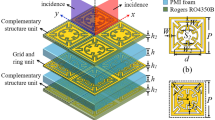Abstract
In this paper, a second-order, dual-band, band-pass frequency selective surface (FSS) with high selectivity is presented by cascading three-layers of periodic metallic arrays. The unit cell in both two exterior layers is composed of gridded-double square loops (G-DSLs) while the element in the middle layer is consisting of wire grid. The three layers are separated by two thin F4B-2 substrates with dielectric constant of 2.65 + 0.02i. The proposed FSS can provide multi-transmission poles and multi-transmission zeros. There are two transmission poles in each pass-band. The two pass-bands are separated by two transmission zeros. On the upper side of the second pass-band, other two transmission zeros are generated also. These transmission zeros lead to a wide out of band rejection and a fast fall off response on both sides of each pass-band. The simulation is implemented using full wave electromagnetic simulator CST Microwave Studio, the central frequencies of the two pass-bands are 12.7 and 17.4 GHz. In addition, the designed principle is described using equivalent circuit model (ECM). Furthermore, the prototype of the FSS is fabricated and measured. Both simulated and measured results demonstrated that the proposed FSS has the merits of incident angle stability from 0° to 60° for both TE and TM polarizations.










Similar content being viewed by others
REFERENCES
T. K. Wu, Frequency Selective Surfaces and Grid Arrays (Wiley, New York, 1995).
B. A. Munk, Frequency Selective Surfaces: Theory and Design (Wiley, New York, 2000).
J. M. Johnson and Y. Rahmat-Samii, “Genetic algorithms in engineering electromagnetics,” IEEE Antennas Propag. Mag. 39, 7–25 (1997).
S. Charkravarty, R. Mittra, and N. R. Williams, “On the application of the microgenetic algorithm to the design of broad-band microwave absorbers comprising frequency-selective surfaces embedded in multilayered dielectric media,” IEEE Trans. Microwave Theory Tech. 49, 1050–1059 (2001).
G. Manara, A. Monorchio, and R. Mittra, “Frequency selective surface design based on genetic algorithm,” Electron. Lett. 36, 1400–1401 (1999).
T. K. Wu and S. W. Lee, “Multiband frequency selective surface with multi-ring patch elements,” IEEE Trans. Antennas Propag. 42, 1484–1490 (1994).
J. Huang, T. K. Wu, and S. H. Lee, “Tri-band frequency selective surface with circular ring elements,” IEEE Trans. Antennas Propag. 42, 166–175 (1994).
J. Romeu and Y. Rahmat-Samii, “Fractal FSS: A novel dual-band frequency selective surface,” IEEE Trans. Antennas Propag. 48, 1097–1105 (2000).
D. H. Werner and D. Lee, “Design of dual-polarized multiband frequency selective surfaces using fractal elements,” Electron. Lett. 36, 487–488 (2000).
X. D. Hu, X. L. Zhou, L. S. Wu, L. Zhou, and W. Y. Yin, “A miniaturized dual-band frequency selective surface (FSS) with closed loop and its complementary pattern,” IEEE Antennas Wireless Propag. Lett. 8, 1374–1377 (2009).
M. Al-Joumayly and N. Behdad, “A new technique for design of low-profile, second-order, bandpass frequency selective surfaces”, IEEE Trans. Antennas Propag. 57, 452–459 (2009).
F. Bayatpur and K. Sarabandi, “Multi-pole spatial filters using metamaterial based miniaturized-element frequency-selective surfaces,” IEEE Trans. Microw. Theory Tech. 56, 2742–2747 (2008).
M. Salehi and N. Behdad, “A second-order dual X-/Ka-band frequency selective surface,” IEEE Microw. Wireless Compon. Lett. 18, 785–787 (2008).
G. Q. Luo, W. Hong, Z. C. Hao, B. Liu, W. D. Li, J. X. Chen, H. X. Zhou, and K. Wu, “Theory and experiment of novel frequency selective surface based on substrate integrated waveguide technology,” IEEE Trans. Antennas Propag. 53, 4035–4043 (2005).
B. Li and Z. X. Shen, “Three dimensional band-pass frequency selective structures with multiple transmission zeros,” IEEE Trans. Microw. Theory Tech. 61, 3578–3589 (2013).
B. Li and Z. X. Shen, “Synthesis of quasi-elliptic bandpass frequency selective surface using cascaded loop arrays,” IEEE Trans. Antennas Propag. 61, 3053–3059 (2013).
C. K. Lee and R. J. Langley, “Equivalent-circuit models for frequency selective surfaces at oblique angles of incidence,” Proc. IEE, Ser. H: Microw., Antennas, Propag. 132, 395–399 (1985).
Author information
Authors and Affiliations
Corresponding author
Additional information
The article is published in the original.
Rights and permissions
About this article
Cite this article
Gao, CY., Pu, H. & Chen, C. Dual-Band High Selective Frequency Selective Surface Design and Analysis. J. Commun. Technol. Electron. 63, 1352–1358 (2018). https://doi.org/10.1134/S1064226918120057
Received:
Published:
Issue Date:
DOI: https://doi.org/10.1134/S1064226918120057




